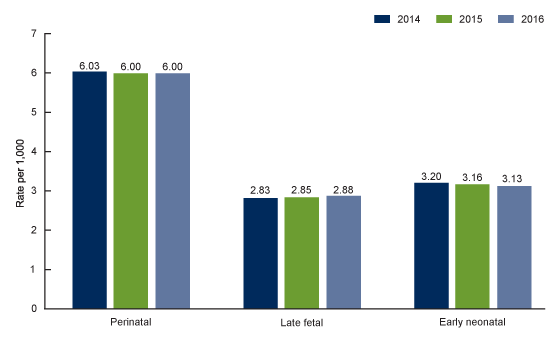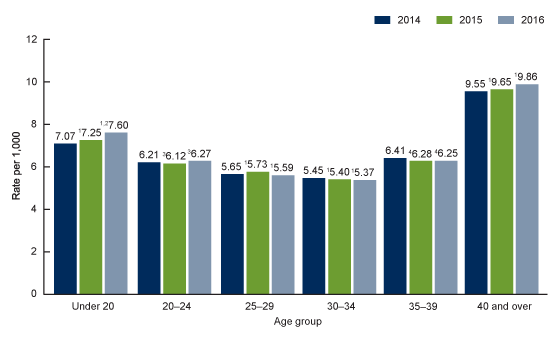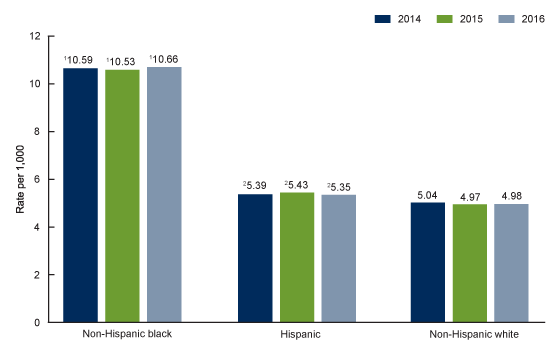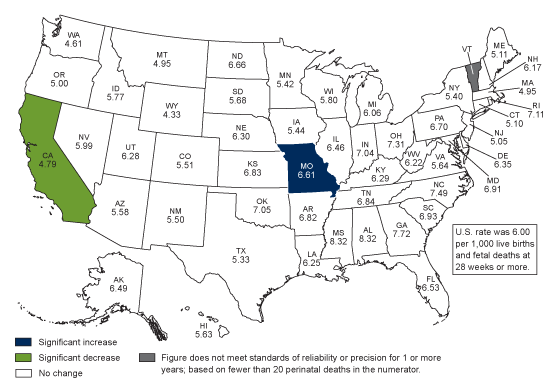Lack of Change in Perinatal Mortality in the United States, 2014–2016
- Key findings
- Late fetal, early neonatal, and perinatal mortality rates were stable from 2014 through 2016.
- Perinatal mortality rates were unchanged for most maternal age groups for 2014 through 2016.
- Perinatal mortality rates were unchanged from 2014 through 2016 by race and Hispanic origin of the mother.
- Perinatal mortality rates remained unchanged for most U.S. jurisdictions in 2016 compared with 2014.
- Summary
- Definitions
- Data sources and methods
- About the authors
- References
- Suggested citation
NCHS Data Brief No. 316, August 2018
PDF Version (510 KB)
Elizabeth C.W. Gregory, M.P.H., Patrick Drake, M.S., and Joyce A. Martin, M.P.H.
Key findings
Data from the National Vital Statistics System
- The U.S. perinatal mortality rate was essentially unchanged from 2014 through 2016 (6.00 perinatal deaths per 1,000 births and late fetal deaths in 2016).
- Late fetal and early neonatal mortality, the two components of perinatal mortality, were also unchanged from 2014 through 2016.
- Perinatal mortality rates were unchanged for the three largest race and Hispanic-origin groups (non-Hispanic black, non-Hispanic white, and Hispanic women) for 2014 through 2016.
- Perinatal mortality rates were stable for all maternal age groups 20 and over from 2014 through 2016; the rate increased for women under age 20 from 7.07 in 2014 to 7.60 in 2016.
- Compared with 2014, perinatal mortality rates remained unchanged for 47 states and the District of Columbia in 2016.
Perinatal mortality (late fetal death at 28 weeks or more and early neonatal death under age 7 days) can be an indicator of the quality of health care before, during, and after delivery (1,2). The U.S. perinatal mortality rate based on the date of the last normal menses (LMP) declined 30% from 1990–2011, but was stable from 2011–2013 (1,3). In 2014, National Center for Health Statistics (NCHS) transitioned to the use of the obstetric estimate of gestational age (OE), introducing a discontinuity in perinatal measures for earlier years (4,5). This report presents trends in perinatal mortality, as well as its components, late fetal and early neonatal mortality, for 2014–2016. Also shown are perinatal mortality trends by mother’s age, race and Hispanic origin, and state for 2014–2016> and state perinatal rates for 2016.
Keywords: fetal death, neonatal death, National Vital Statistics System
Late fetal, early neonatal, and perinatal mortality rates were stable from 2014 through 2016.
- Late fetal and early neonatal morality rates were essentially unchanged from 2014 through 2016. The late fetal mortality rate was 2.83 in 2014 compared with 2.88 in 2016; the early neonatal mortality rate was 3.20 in 2014 compared with 3.13 in 2016 (Figure 1).
- Consistent with the lack of change in late fetal and early neonatal mortality for 2014–2016, the perinatal mortality rate was also stable from 2014 (6.03) through 2016 (6.00).
Figure 1. Perinatal, late fetal, and early neonatal mortality rates: United States, 2014–2016
NOTES: Perinatal mortality rate is the number of infant deaths under age 7 days and fetal deaths at 28 weeks of gestation or more per 1,000 live births and fetal deaths at 28 weeks of gestation or more. Late fetal mortality rate is the number of fetal deaths at 28 weeks of gestation or more per 1,000 live births and fetal deaths at 28 weeks of gestation or more. Early neonatal mortality rate is the number of infant deaths under age 7 days per 1,000 live births. Access data table for Figure 1.
SOURCE: NCHS, National Vital Statistics System.
Perinatal mortality rates were unchanged for most maternal age groups for 2014 through 2016.
- Perinatal mortality rates were unchanged for women aged 20 and over for 2014 through 2016; the rate increased for women under age 20 from 7.07 in 2014, to 7.25 in 2015 and 7.60 in 2016 (Figure 2).
- Patterns of perinatal mortality by age were the same for each year 2014–2016. Rates were highest for women aged 40 and over (9.86 in 2016) and lowest for women aged 30–34 (5.37 in 2016).
Figure 2. Perinatal mortality rates, by age of mother: United States, 2014–2016
1Significant difference from other age groups for each year across 3 years (p < 0.05).
2Significant increasing linear trend from 2014 through 2016 (p < 0.05).
3Significant difference from other age groups except 35–39 for each year across 3 years (p < 0.05).
4Significant difference from other age groups except 20–24 for each year across 3 years (p < 0.05).
NOTES: Perinatal mortality rate is the number of infant deaths under age 7 days and fetal deaths at 28 weeks of gestation or more per 1,000 live births and fetal deaths at 28 weeks of gestation or more in a specified age group. Access data table for Figure 2.
SOURCE: NCHS, National Vital Statistics System.
Perinatal mortality rates were unchanged from 2014 through 2016 by race and Hispanic origin of the mother.
- There was no change in perinatal mortality for any of the three largest race and Hispanic-origin groups for 2014–2016 (Figure 3). The rate for non-Hispanic black women was 10.59 in 2014 compared with 10.66 in 2016; the rate for Hispanic women was 5.39 in 2014 compared with 5.35 in 2016; and the rate for non-Hispanic white women was 5.04 in 2014 compared with 4.98 in 2016.
- The perinatal mortality rate for non-Hispanic black women was approximately twice as high as the rates for both non-Hispanic white and Hispanic women for all three years.
- The perinatal mortality rate for Hispanic women was 7%–9% higher than the rate for non-Hispanic white women for the years 2014–2016.
Figure 3. Perinatal mortality rates, by race and Hispanic origin of mother: 49 states and the District of Columbia, 2014–2016
1Significant difference from Hispanic and non-Hispanic white women for each year across 3 years (p < 0.05).
2Significant difference from non-Hispanic white women for each year across 3 years (p < 0.05).
NOTES: Perinatal mortality rate is the number of infant deaths under age 7 days and fetal deaths at 28 weeks of gestation or more per 1,000 live births and fetal deaths at 28 weeks of gestation or more in a specified race and Hispanic-origin group. All years exclude data for Rhode Island, which did not report mother’s race or Hispanic origin for fetal deaths for 2015. Access data table for Figure 3.
SOURCE: NCHS, National Vital Statistics System.
Perinatal mortality rates remained unchanged for most U.S. jurisdictions in 2016 compared with 2014.
- Perinatal mortality rates were unchanged in 47 states and the District of Columbia in 2016 compared with 2014 (Figure 4). The rate declined in California and increased in Missouri.
- The perinatal mortality rate for the United States was 6.00 in 2016. This rate ranged by state from a low of 4.33 in Wyoming, to a high of 8.32 in Alabama and Mississippi. The rate for the District of Columbia was 6.88.
- Compared with the U.S. rate of 6.00, the perinatal mortality rate was lower in 10 states, higher in 14 states, and not significantly different for 25 states and the District of Columbia.
Figure 4. Perinatal mortality rates by state for 2016 and change in 2016 compared with 2014
NOTES: Rate per 1,000 live births and fetal deaths at 28 weeks or more. Significant increase or decrease at p < 0.05. Access data table for Figure 4.
SOURCE: NCHS, National Vital Statistics System.
Summary
Rates of perinatal mortality and its components, late fetal and early neonatal mortality, based on the LMP measure of gestational age were essentially flat from 2011 through 2013 (1,6). This report demonstrates a similar lack of change in the perinatal mortality rate based on the OE measure from 2014 through 2016. During this time, the perinatal mortality rates for the three largest race and Hispanic-origin groups were unchanged, as were those for most maternal age groups and in the vast majority of states. The rate of perinatal mortality for non-Hispanic black women was about twice as high as those for non-Hispanic white and Hispanic women for each year from 2014 through 2016. Differences in the risk of perinatal mortality were observed by maternal age and by state.
Definitions
Late fetal death: A fetal death at 28 completed weeks of gestation or more.
Late fetal mortality rate: Number of fetal deaths at 28 completed weeks of gestation or more per 1,000 live births and fetal deaths at 28 completed weeks of gestation or more.
Early neonatal death: Death of a live-born infant under age 7 days.
Early neonatal mortality rate: Number of infant deaths under age 7 days per 1,000 live births.
Perinatal death: Infant deaths under age 7 days and fetal deaths at 28 completed weeks of gestation or more.
Perinatal mortality rate: Number of infant deaths under age 7 days and fetal deaths at 28 completed weeks of gestation or more per 1,000 live births and fetal deaths at 28 completed weeks of gestation or more.
Data sources and methods
This report contains data from the Fetal Death Data File and the Linked Birth/Infant Death Data File from the National Vital Statistics System (NVSS). The National Vital Statistics Fetal Death Data File contains information from all reports of fetal death filed in the 50 states, the District of Columbia, and the U.S. territories. Although reporting requirements for fetal deaths vary somewhat by state, fetal mortality rates from NVSS generally represent fetal deaths of 20 weeks of gestation or more (1). Fetal death data from NVSS are available by a wide range of maternal and infant characteristics (7). The Linked Birth/Infant Death Data File provides information on fetal deaths and live births in the United States (8). Fetal Death and Linked Birth/Infant Death data sets.
Beginning with the 2014 data year, NCHS transitioned to a new standard to measure gestational age. The new measure—the OE—replaced the measure based on the LMP. The two measures result in somewhat different estimates of the numbers and rates of total fetal (20 weeks or more), early fetal (less than 28 weeks), late fetal (28 weeks or more), and perinatal (infant deaths under 7 days and fetal deaths at 28 weeks or more) deaths (5). The late fetal and perinatal mortality rates presented in this report are based on the OE and differ somewhat from the LMP-based rates published in reports for data years 2013 and earlier (1,3).
Perinatal rates by race and Hispanic origin of the mother for 2014–2016 exclude data for Rhode Island, which did not report race and Hispanic-origin data for fetal deaths in 2015.
The difference between any rates noted in the text are statistically significant at the 0.05 level unless otherwise noted. References to decreasing or increasing linear trends are statistically significant at the 0.05 level and assessed using the Cochran-Armitage test for trends, a modified chi-squared test.
About the authors
Elizabeth C.W. Gregory, Patrick Drake, and Joyce A. Martin are with the National Center for Health Statistics, Division of Vital Statistics, Reproductive Statistics Branch.
References
- MacDorman MF, Gregory ECW. Fetal and perinatal mortality: United States, 2013. National Vital Statistics Reports; vol 64 no 8. Hyattsville, MD: National Center for Health Statistics. 2015.
- World Health Organization. Neonatal and perinatal mortality: Country, regional and global estimates. 2006.
- MacDorman MF, Kirmeyer SE, Wilson EC. Fetal and perinatal mortality, United States, 2006. National Vital Statistics Reports; vol 60 no 8. Hyattsville, MD: National Center for Health Statistics. 2012.
- Martin JA, Osterman MJK, Kirmeyer SE, Gregory ECW. Measuring gestational age in vital statistics data: Transitioning to the obstetric estimate. National Vital Statistics Reports; vol 64 no 5. Hyattsville, MD: National Center for Health Statistics. 2015.
- National Center for Health Statistics. User guide to the 2016 fetal death public use file.
- National Center for Health Statistics. User guide to the period linked birth/infant death public use file (published annually).
- National Center for Health Statistics. Fetal death public-use file (published annually).
- National Center for Health Statistics. Linked birth/infant death public-use file (published annually).
Suggested citation
Gregory ECW, Drake P, Martin JA. Lack of change in perinatal mortality in the United States, 2014–2016. NCHS Data Brief, no 316. Hyattsville, MD: National Center for Health Statistics. 2018.
Copyright information
All material appearing in this report is in the public domain and may be reproduced or copied without permission; citation as to source, however, is appreciated.
National Center for Health Statistics
Charles J. Rothwell, M.S., M.B.A., Director
Jennifer H. Madans, Ph.D., Associate Director for Science
Division of Vital Statistics
Delton Atkinson, M.P.H., M.P.H., P.M.P., Director
Hanyu Ni, Ph.D., M.P.H., Associate Director for Science



